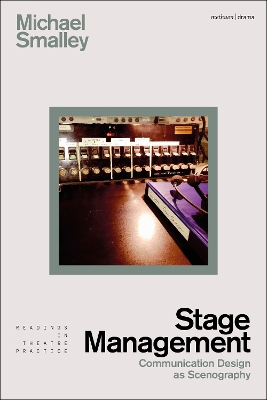Stage Management
 -10%
portes grátis
-10%
portes grátis
Stage Management
Communication Design as Scenography
Smalley, Michael; Shepherd, Simon
Bloomsbury Publishing PLC
01/2024
224
Dura
Inglês
9781137607683
15 a 20 dias
Descrição não disponível.
List of Figures
Series Preface
Acknowledgements
Introductions
Assumptions
Synopsis
Interviews
Part One: Various Stage Management Approaches
Chapter 1 - Developments Over Time
Chapter 2 - Cultural Differences
Different Stage Management Approaches in the UK, North America and Australia
Intercultural Stage Management
Cultural Diversity and Stage Management
Conclusions
Chapter 3 - Content-driven Differences
Genre
Different Scales of Production
Conclusions.
Chapter 4 - Recent Developments
Communication Technology
Performance Technology
New Approaches to Maintaining Productions
Developments in Health and Safety Management
Conclusions
Chapter 5 - Three Models of Stage Management Practice
The Administrative Model
Features
Limitations
The Managerial Model
The Artistic Model
Artistry
Communication Design
Audience Experience
Conclusions
Part Two: Scenographic Stage Management
Chapter 6 - Scenographic Stage Management
Other Technical Theatre Disciplines
Scenography
Analysing Scenography
The Coordinates Model of Scenography
Conclusions
Chapter 7 - Objectives of Stage Management
Selective Information Flow
Targeted Information Flow.
Distributed Cognition
Controlling the Mood and Atmosphere
Translation
Conclusions
Chapter 8 - The Properties of Communication
Message
Mode
Distribution
Updates
Conclusions
Chapter 9 - Rationales, Implications and Conclusions
Rationales
Implications
Conclusions
Notes
Index
Series Preface
Acknowledgements
Introductions
Assumptions
Synopsis
Interviews
Part One: Various Stage Management Approaches
Chapter 1 - Developments Over Time
Chapter 2 - Cultural Differences
Different Stage Management Approaches in the UK, North America and Australia
Intercultural Stage Management
Cultural Diversity and Stage Management
Conclusions
Chapter 3 - Content-driven Differences
Genre
Different Scales of Production
Conclusions.
Chapter 4 - Recent Developments
Communication Technology
Performance Technology
New Approaches to Maintaining Productions
Developments in Health and Safety Management
Conclusions
Chapter 5 - Three Models of Stage Management Practice
The Administrative Model
Features
Limitations
The Managerial Model
The Artistic Model
Artistry
Communication Design
Audience Experience
Conclusions
Part Two: Scenographic Stage Management
Chapter 6 - Scenographic Stage Management
Other Technical Theatre Disciplines
Scenography
Analysing Scenography
The Coordinates Model of Scenography
Conclusions
Chapter 7 - Objectives of Stage Management
Selective Information Flow
Targeted Information Flow.
Distributed Cognition
Controlling the Mood and Atmosphere
Translation
Conclusions
Chapter 8 - The Properties of Communication
Message
Mode
Distribution
Updates
Conclusions
Chapter 9 - Rationales, Implications and Conclusions
Rationales
Implications
Conclusions
Notes
Index
Assunto não disponível.
administration; organizations; artistry; communication; live performance; scenography; Miracle Plays; intercultural; intersectional; scale; touring; morale; audience connection; resource deployment; relationship; information flow; distributed cognition; mood; atmosphere; lighting design
List of Figures
Series Preface
Acknowledgements
Introductions
Assumptions
Synopsis
Interviews
Part One: Various Stage Management Approaches
Chapter 1 - Developments Over Time
Chapter 2 - Cultural Differences
Different Stage Management Approaches in the UK, North America and Australia
Intercultural Stage Management
Cultural Diversity and Stage Management
Conclusions
Chapter 3 - Content-driven Differences
Genre
Different Scales of Production
Conclusions.
Chapter 4 - Recent Developments
Communication Technology
Performance Technology
New Approaches to Maintaining Productions
Developments in Health and Safety Management
Conclusions
Chapter 5 - Three Models of Stage Management Practice
The Administrative Model
Features
Limitations
The Managerial Model
The Artistic Model
Artistry
Communication Design
Audience Experience
Conclusions
Part Two: Scenographic Stage Management
Chapter 6 - Scenographic Stage Management
Other Technical Theatre Disciplines
Scenography
Analysing Scenography
The Coordinates Model of Scenography
Conclusions
Chapter 7 - Objectives of Stage Management
Selective Information Flow
Targeted Information Flow.
Distributed Cognition
Controlling the Mood and Atmosphere
Translation
Conclusions
Chapter 8 - The Properties of Communication
Message
Mode
Distribution
Updates
Conclusions
Chapter 9 - Rationales, Implications and Conclusions
Rationales
Implications
Conclusions
Notes
Index
Series Preface
Acknowledgements
Introductions
Assumptions
Synopsis
Interviews
Part One: Various Stage Management Approaches
Chapter 1 - Developments Over Time
Chapter 2 - Cultural Differences
Different Stage Management Approaches in the UK, North America and Australia
Intercultural Stage Management
Cultural Diversity and Stage Management
Conclusions
Chapter 3 - Content-driven Differences
Genre
Different Scales of Production
Conclusions.
Chapter 4 - Recent Developments
Communication Technology
Performance Technology
New Approaches to Maintaining Productions
Developments in Health and Safety Management
Conclusions
Chapter 5 - Three Models of Stage Management Practice
The Administrative Model
Features
Limitations
The Managerial Model
The Artistic Model
Artistry
Communication Design
Audience Experience
Conclusions
Part Two: Scenographic Stage Management
Chapter 6 - Scenographic Stage Management
Other Technical Theatre Disciplines
Scenography
Analysing Scenography
The Coordinates Model of Scenography
Conclusions
Chapter 7 - Objectives of Stage Management
Selective Information Flow
Targeted Information Flow.
Distributed Cognition
Controlling the Mood and Atmosphere
Translation
Conclusions
Chapter 8 - The Properties of Communication
Message
Mode
Distribution
Updates
Conclusions
Chapter 9 - Rationales, Implications and Conclusions
Rationales
Implications
Conclusions
Notes
Index

